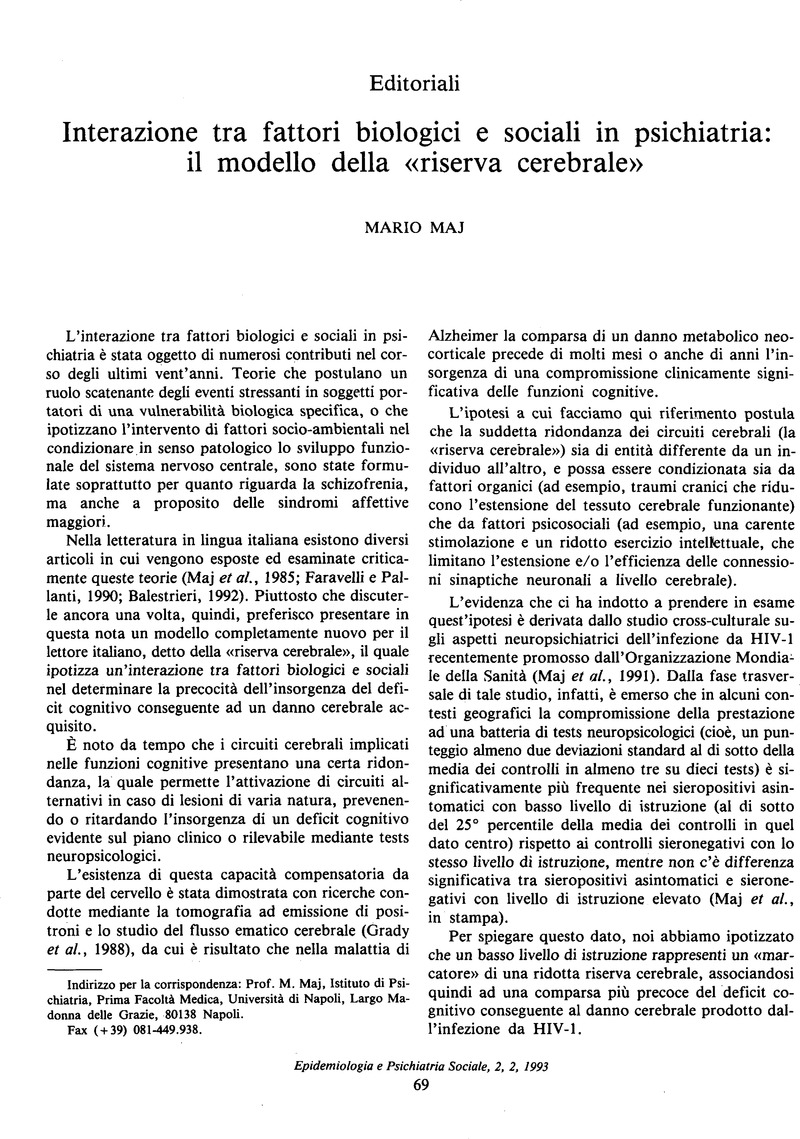No CrossRef data available.
Article contents
Interazione tra fattori biologici e sociali in psichiatria: il modello della «riserva cerebrale»
Published online by Cambridge University Press: 11 October 2011
Abstract
An abstract is not available for this content so a preview has been provided. As you have access to this content, a full PDF is available via the ‘Save PDF’ action button.

- Type
- Editoriali
- Information
- Copyright
- Copyright © Cambridge University Press 1993
References
BIBLIOGRAFIA
Balestrieri, A. (1992). Darwinismo neuronale, epigenesi selettiva, personalità e schizofrenia. Rivista di Psichiatrià 27, 1–5.Google Scholar
Faravelli, C. & Pallanti, S. (1990). Accadimenti ambientali e malattia. In Psichiatria Medica (ed. Cassano, G. B.), pp. 157–170. UTET: Torino.Google Scholar
Gedye, A., Beattie, B. L., Tuokko, H., Horton, A. & Korsarek, E. (1989). Severe head injury hastens age of onset of Alzheimer's disease. Journal of the American Geriatrics Society 37, 970–973.CrossRefGoogle ScholarPubMed
Grady, C. L., Haxby, J. V., Horwitz, B., Sundaram, M., Berg, G., Schapiro, M., Friedland, R. P. & Rapoport, S. I. (1988). Longitudinal study of the early neuropsychological and cerebral metabolic changes in dementia of the Alzheimer type. Journal of Clinical and Experimental Neuropsychology 10, 576–596.CrossRefGoogle ScholarPubMed
Maj, M., Gritti, P. & Galderisi, S. (1985). La «diathesis-stress theory» della schizofrenia: basi teoriche ed implicazioni terapeutiche. Neurologia, Psichiatria, Scienze Umane 5, 140–156.Google Scholar
Maj, M., Janssen, R., Satz, P., Zaudig, M., Starace, F., Boor, D., Sughondhabirom, B., Bing, E. G., Luabeya, M., Ndetei, D., Riedel, R., Schulte, G. & Sartorius, N. (1991). The World Health Organization's cross-cultural study on neuropsychiatric aspects of infection with the human immunodeficiency virus 1 (HIV-1). Preparation and pilot phase. British Journal of Psychiatry 159, 351–356.CrossRefGoogle ScholarPubMed
Maj, M., Satz, P., Janssen, R., Zaudig, M., Starace, F., d'Elia, L., Sughondhabirom, B., Mussa, M., Bing, E. G., Naber, D., Ndetei, D., Schulte, G. & Sartorius, N. (in stampa). WHO Neuropsychiatric AIDS Study, cross-sectional phase. II. Neuropsycho-logical and neurological findings. Archives of General Psychiatry.Google Scholar
Mortimer, J. A., van Duijn, C. M., Chandra, V., Fratiglioni, L., Graves, A. B., Heyman, A., Jorm, A. F., Kokmen, E., Rocca, W. A., Shalat, S. L., Soininen, H. & Hofman, A. (1991). Head trauma as a risk factor for Alzheimer's disease: a collaborative re-analysis of case-control studies. International Journal of Epidemiology 20, S28–S35.CrossRefGoogle Scholar
Roberts, G. W., Allsop, D. & Bruton, C. (1990). The occult after-math of boxing. Journal of Neurology, Neurosurgery and Psychiatry 53, 373–378.CrossRefGoogle Scholar
Stern, Y., Alexander, G., Prohovnik, I. & Mayeux, R. (1991). Education provides a cognitive reserve against the clinical manife-stations of Alzheimer's disease: evidence form regional cerebral blood flow. Society for Neuroscience Abstracts 17, 1258.Google Scholar


